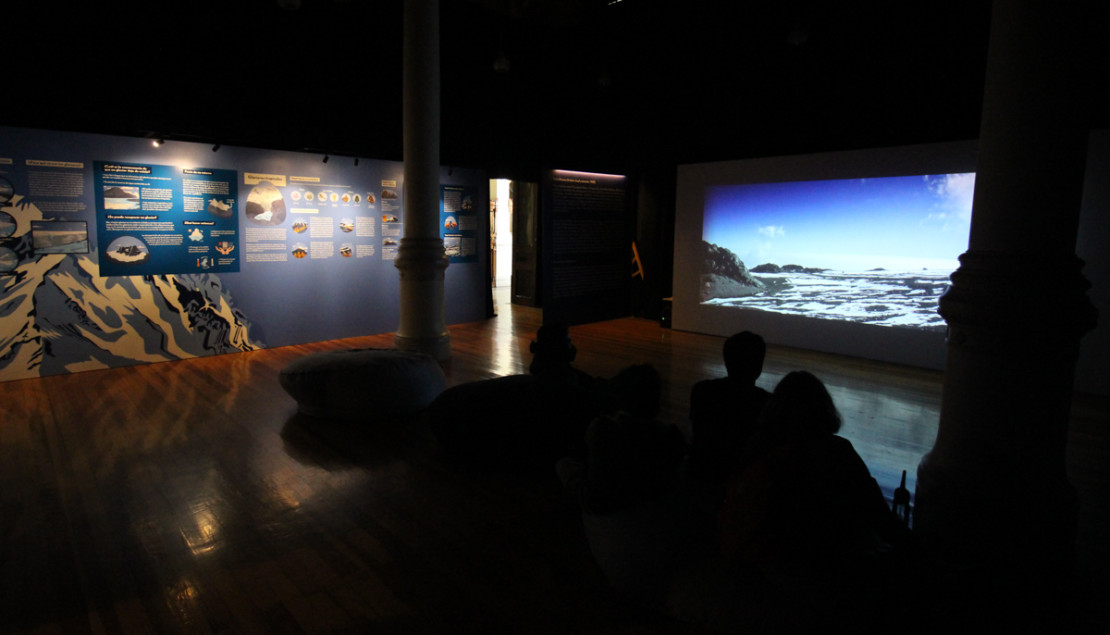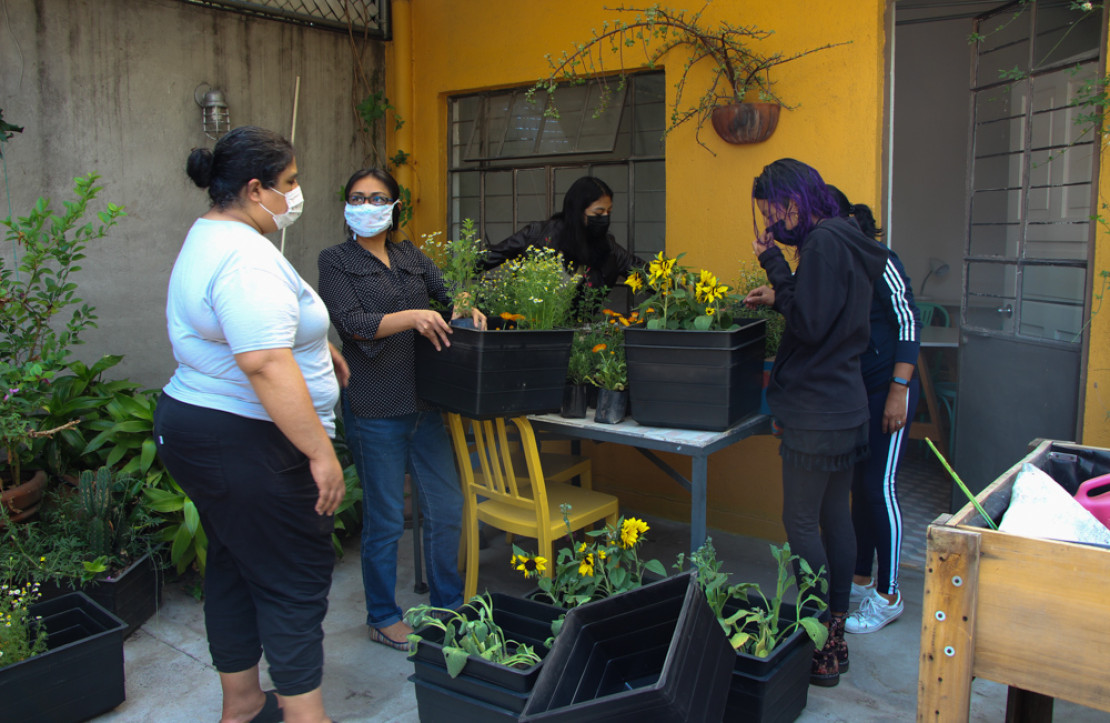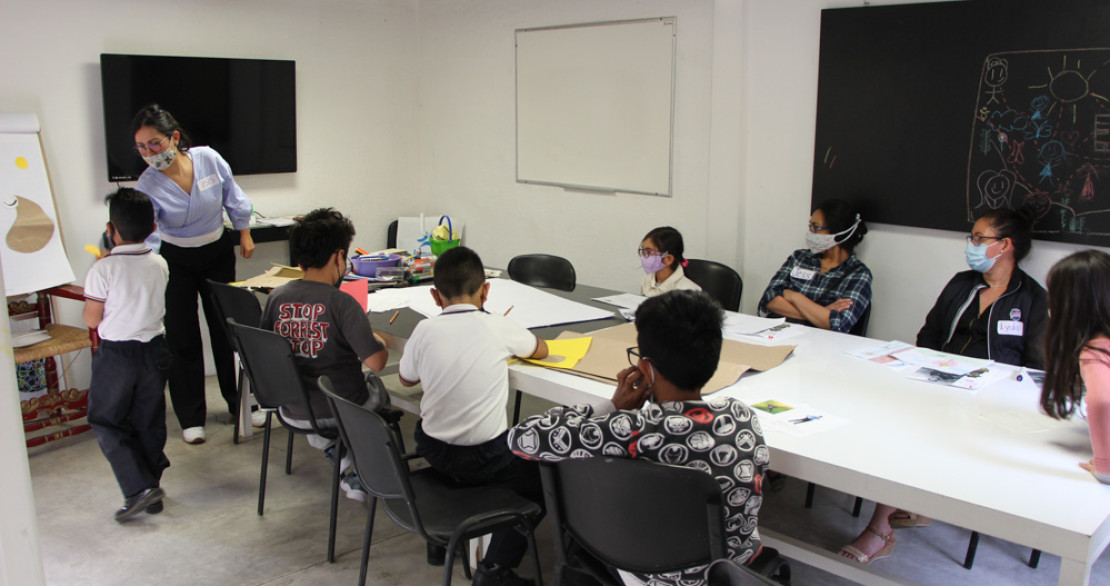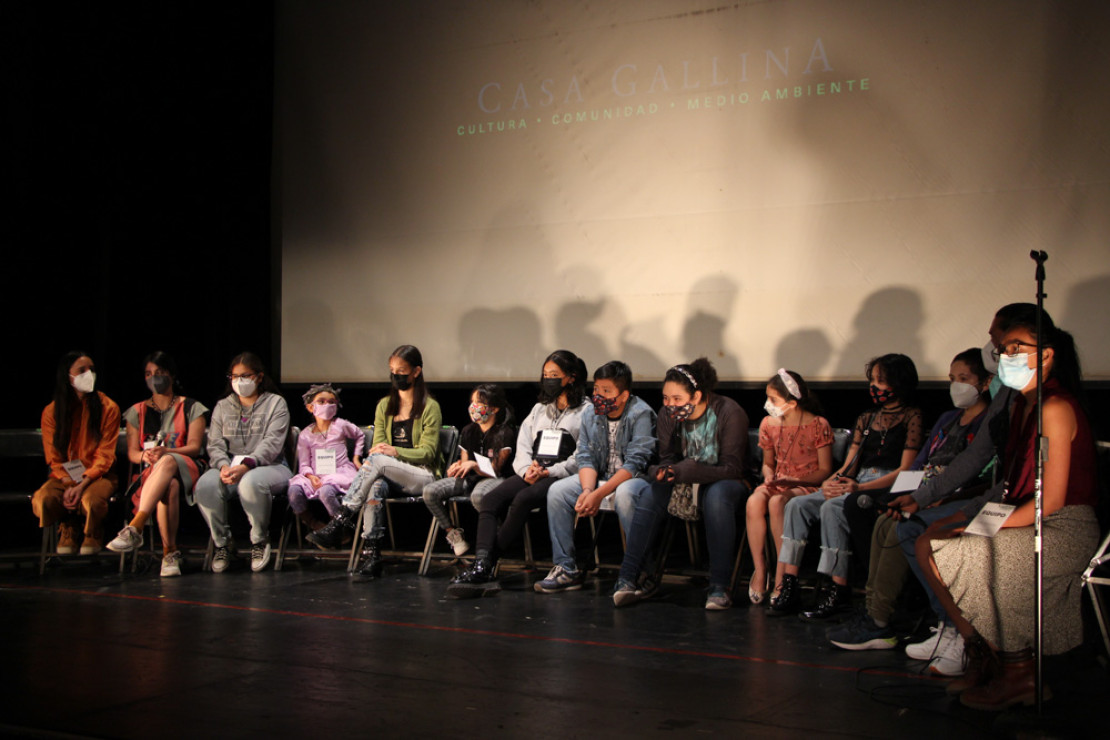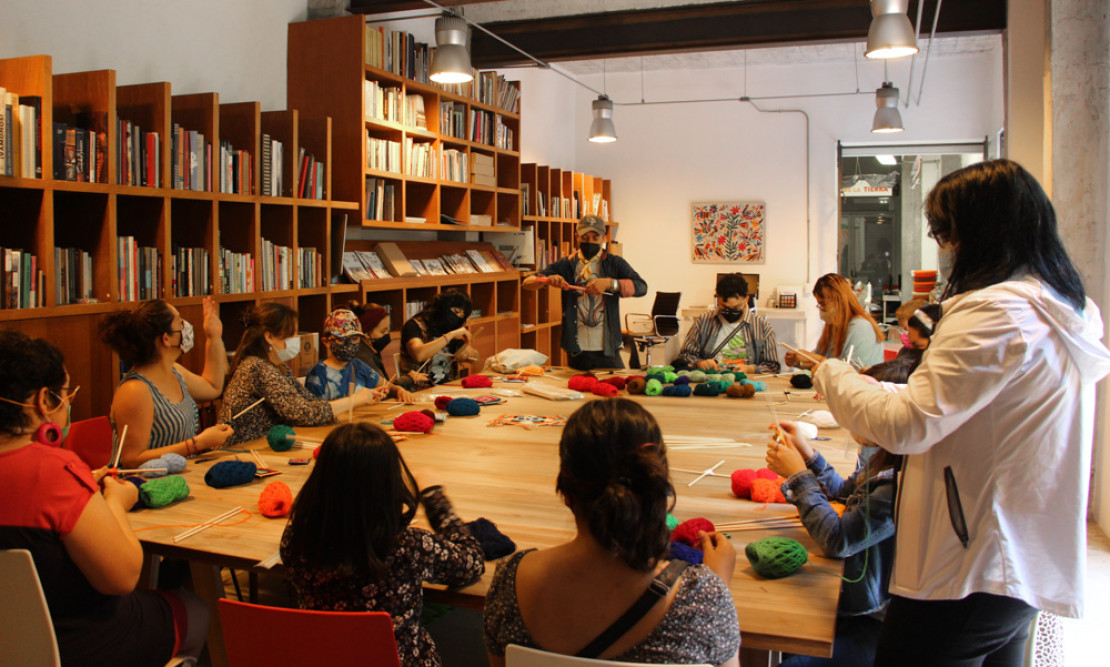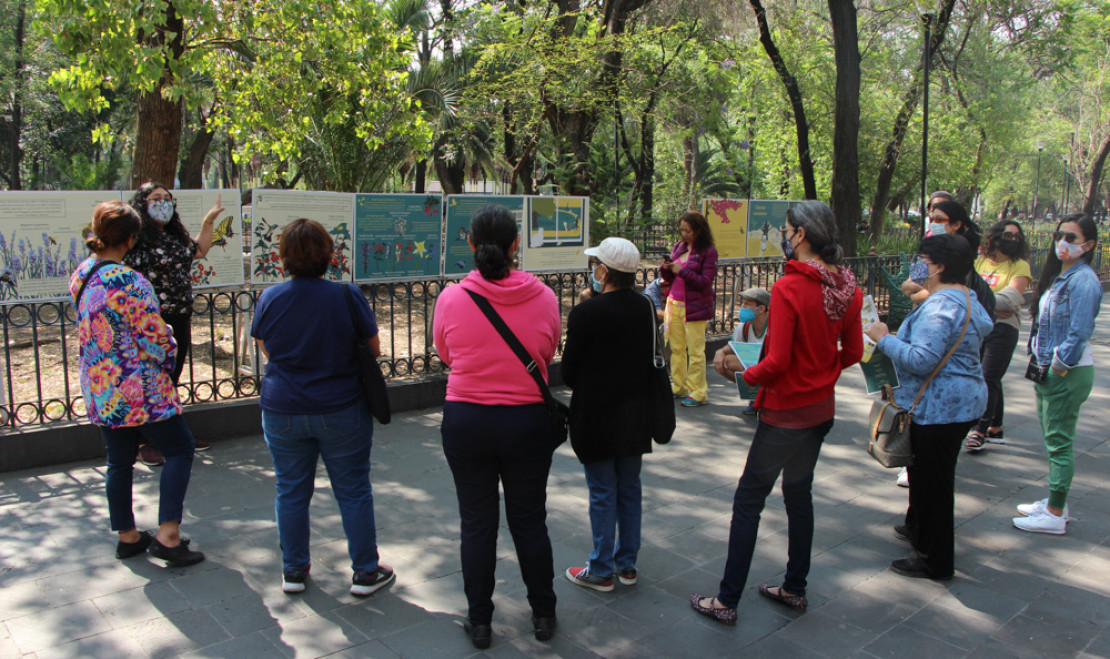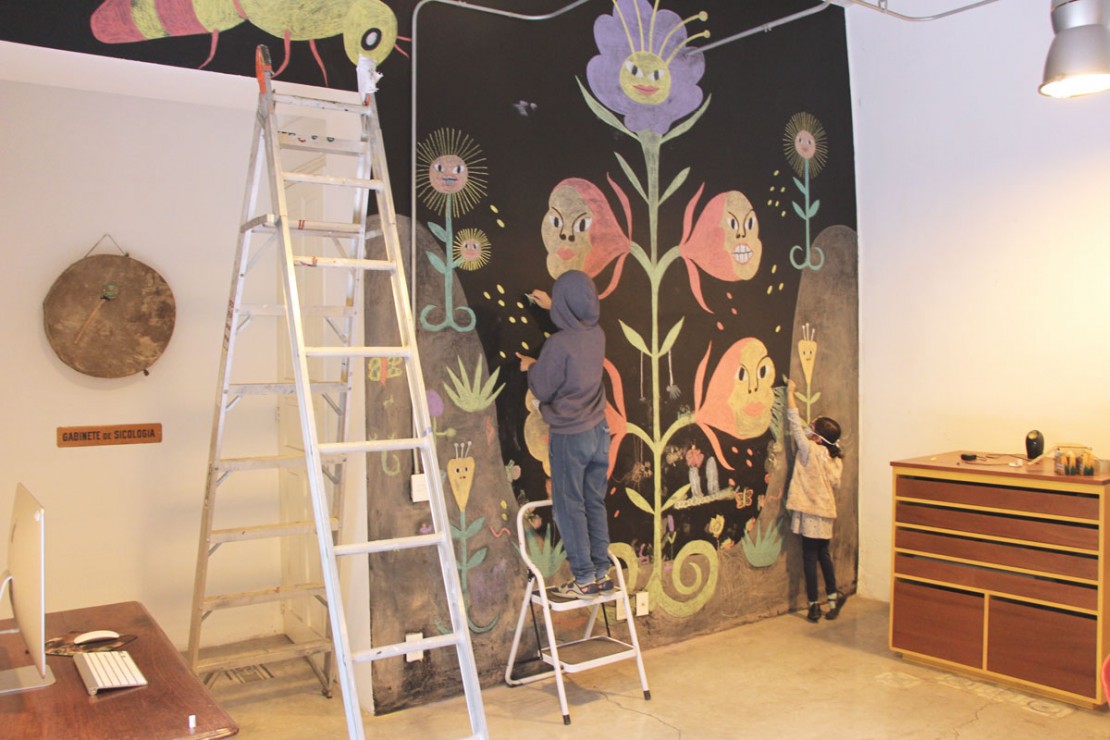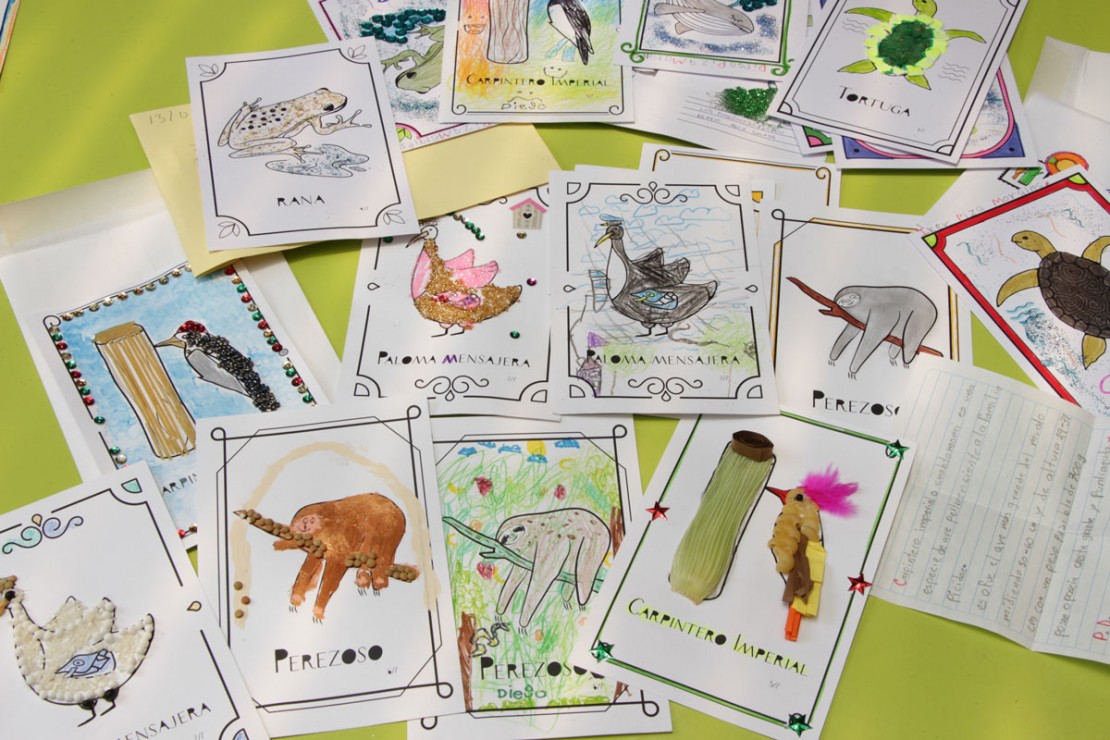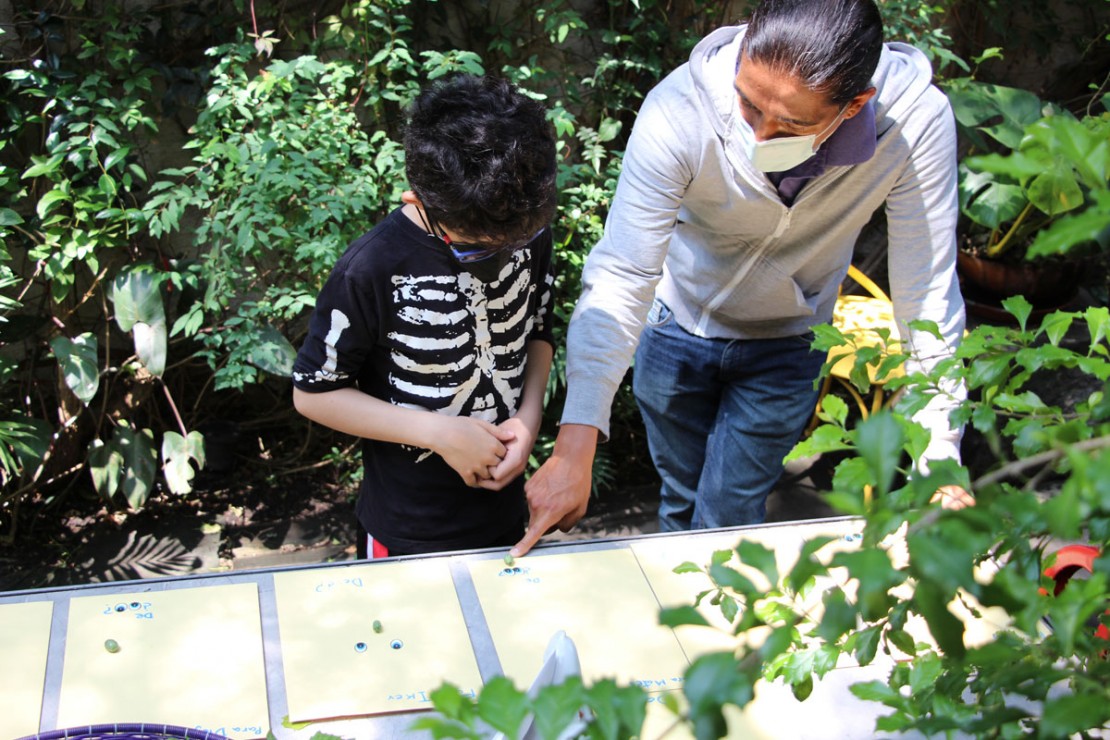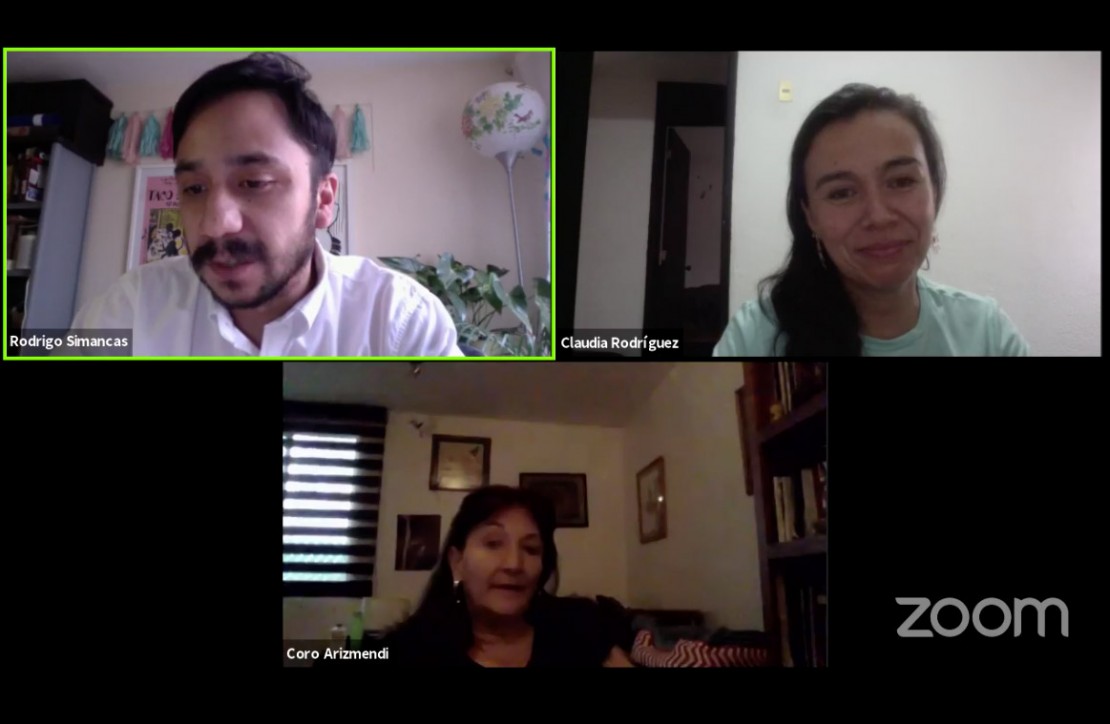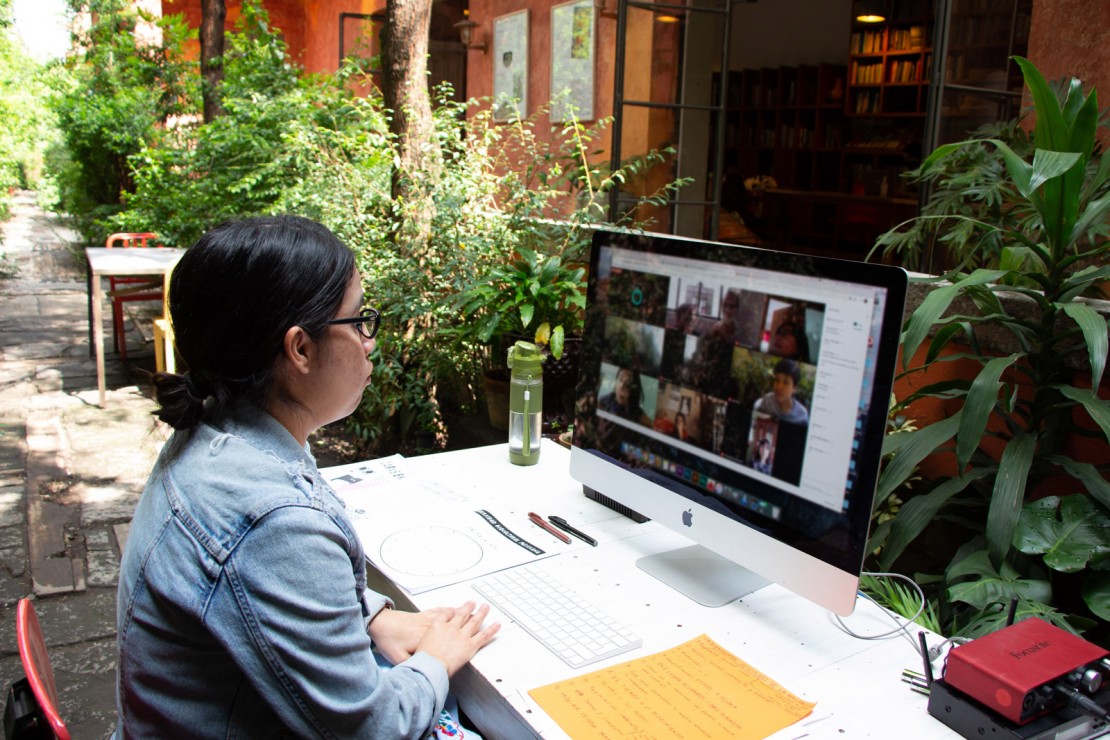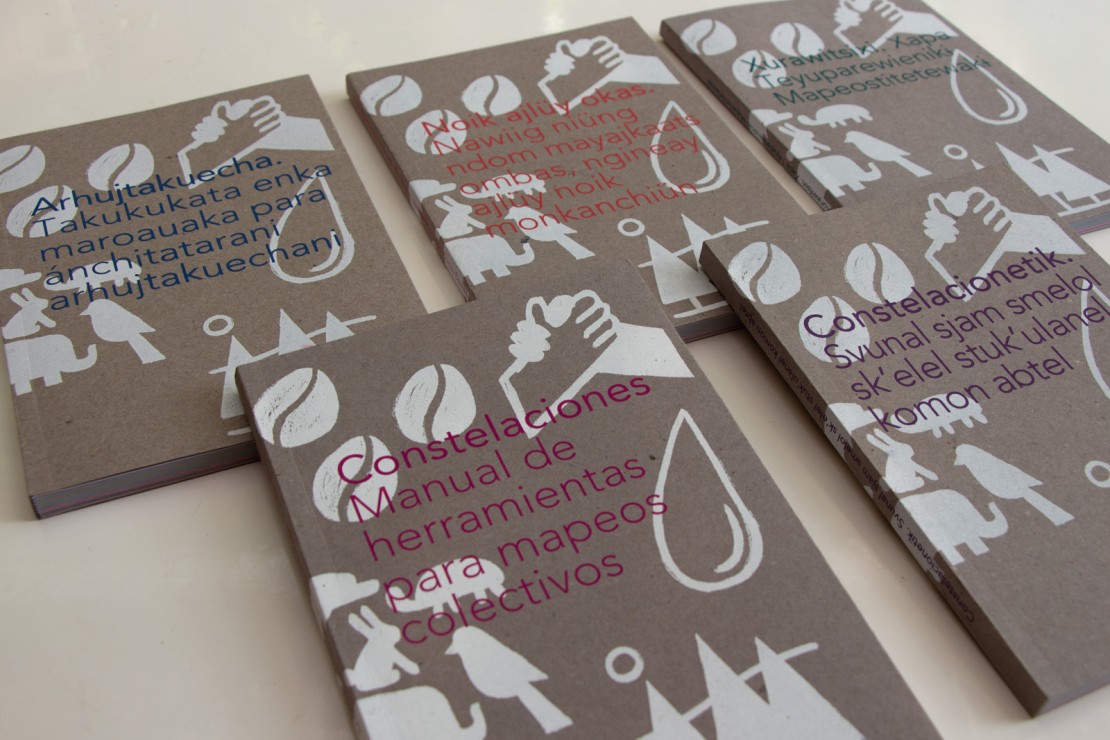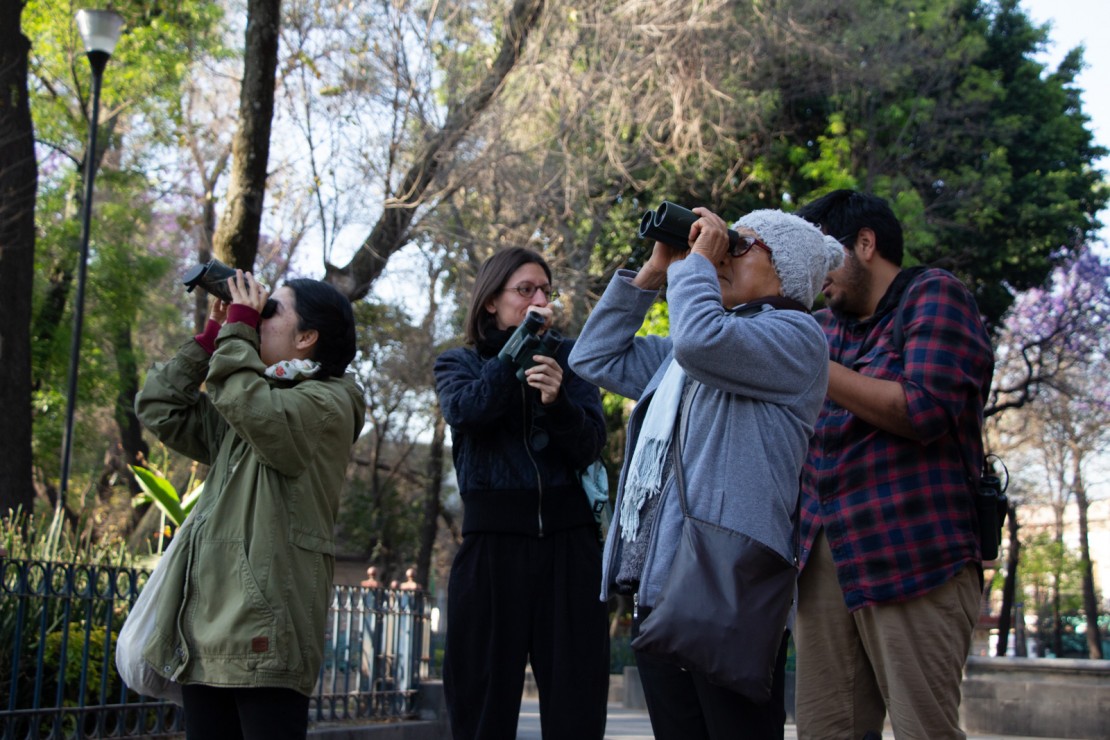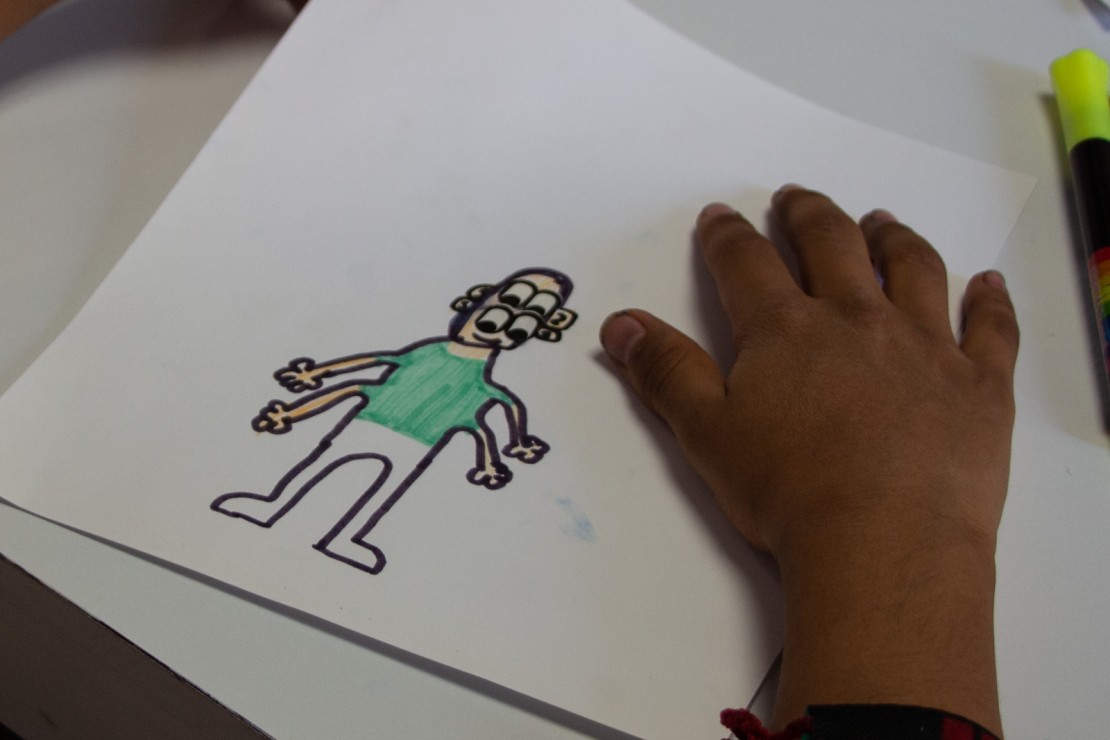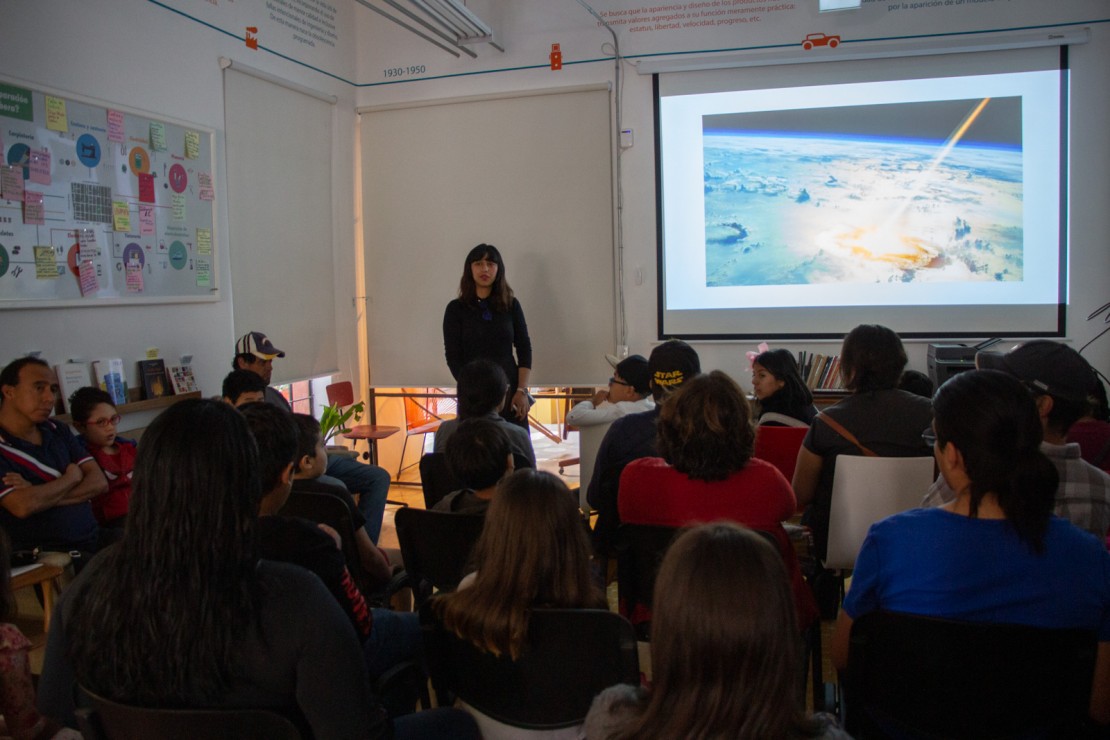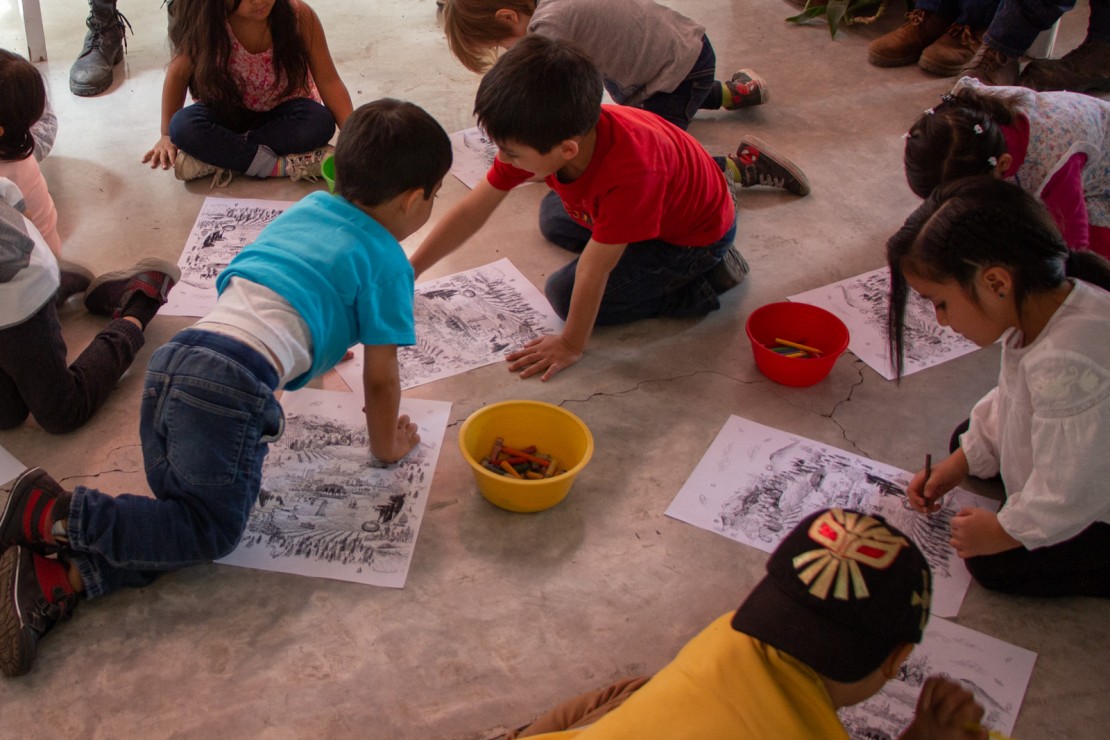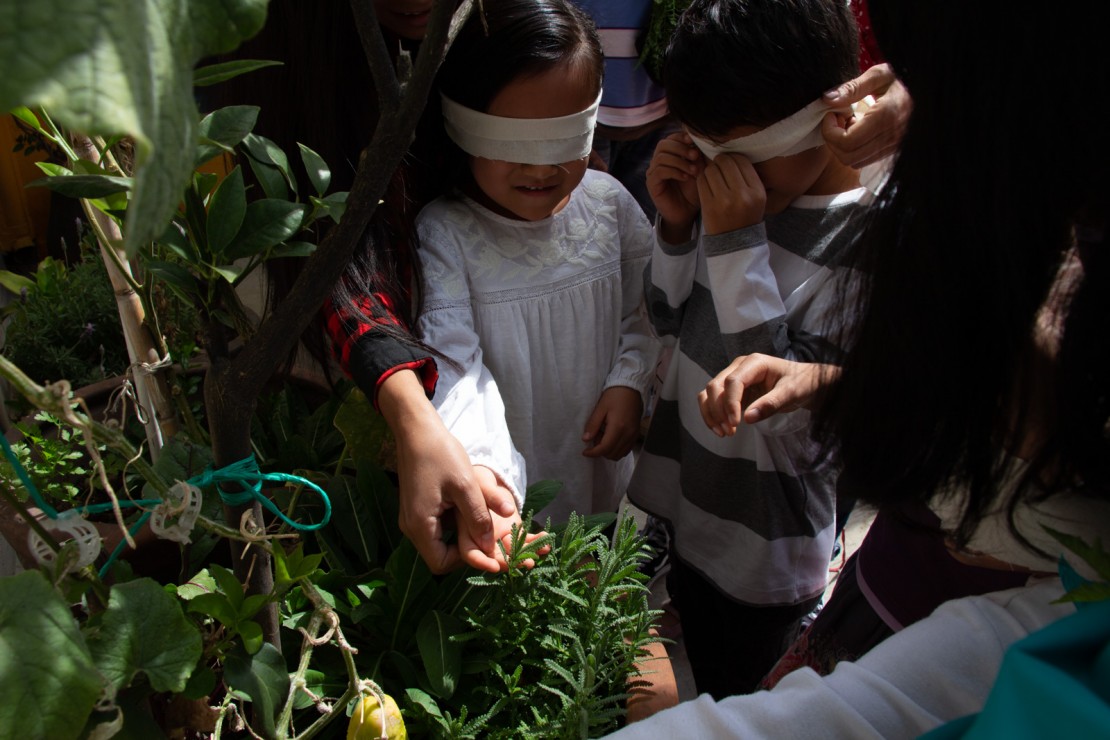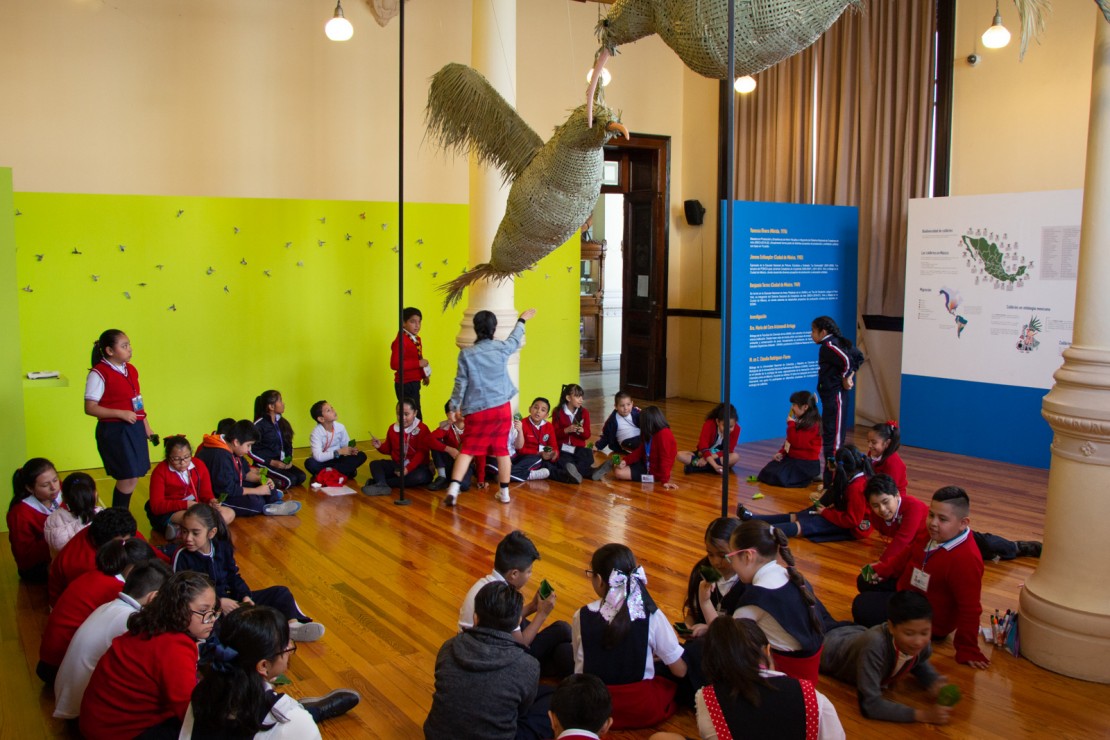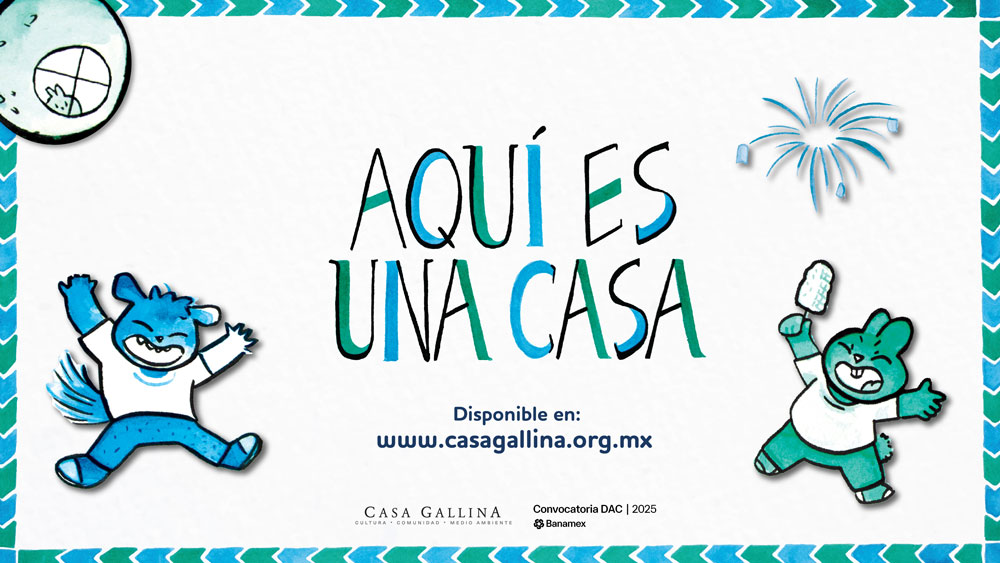Biocultural diversity
The various components of the program aim to encourage a critical perspective on the impact of human actions on the preexisting balances of natural ecosystems. The contents provided tools for analyzing current situations, reviewing their evolution over time and proposing possibilities for action in everyday life to transform them.
The strategy was built in alliance with specialists who propose multidisciplinary perspectives from biology, permaculture, linguistics, anthropology and art. The programs are implemented in the Santa María la Ribera neighborhood as well as in other territories, collaborating with local initiatives such as Na Bolom in San Cristóbal de las Casas (Chiapas), Neanch Collective in San Mateo del Mar (Oaxaca), as well as through alliances with community agents in tsotsil-, wixárika-, ombeayiüts- and purépecha-speaking territories, among others.
Hands To the Ground 2 - Inhabitants of the Orchard
Date - From January 20 to April 28, 2025
Facilitated by - Fabiola Gallardo and Moises Ledezma
Participants - 32 children and 25 adults, inhabitants of Santa Maria la Ribera
This workshop was developed to introduce boys and girls aged between 3 and 6 to the orchard where, through different sensorial activities, the participants started small-scale agricultural production. This second edition concentrated on seed germination and how the work of worms —or annelids— helps a plant develop. Therefore, the children were able to construct a worm farm together, which they will give regular maintenance to with species from the orchard, as well as a planting bed measuring 1 m2.
9th Encounter With Earth: Recreate
Date: 22 October, 2024
Facilitated by: Moisés Ledesma, Cecilia Pompa, Sofía Ortega and Mariana Malinalli
Ally: Instituto de Geología and Geology Museum of the UNAM
Participants: 110 visitors
In the framework of the 9th Encounter With Earth, organized by the Geology Museum on Santa María la Ribera’s main square, we held educational activities based on Recreate: a compilation of educational strategies. We drew, wrote and proposed alternatives to care for water along with the visitors. In addition, we offered two guided visits to the exhibition Rainy and Dry. The Ancestral Vision of Time in Milpa Alta in the Geology Museum.
Green Afternoons: Get to Know Casa Gallina’s Orchard
Date:22 August, 2024
Facilitated by: Camilo A. Pérez
Participants: 8 inhabitants of Santa Maria la Ribera
The initiative Green Afternoons aimed to introduce the orchard in the house to new neighbors interested in urban agriculture. By opening the orchard’s door as a space for learning and experimenting, the participants could observe and hear the voice of other neighbors’ experiences in this space. The session ended with picking pumpkins and preparing a joint supper.
Feel the Garden: Visits to Gardens in Mexico City
Dates:22, 29 June and 6 July, 2024
Facilitated by: Sami Esfahani
Allies: Botanical Garden at the UNAM and gardens of the Vasconcelos Library
Participants: 7 inhabitants of Santa Maria la Ribera
This program consisted of 3 sessions with inhabitants from the neighborhood and was conceived to see some examples of botanical gardens and their relations within Mexico City. We visited the UNAM’s botanical garden and the garden of the Vasconcelos Library as well as Casa Gallina’s garden, where we discussed the effects and relations city dwellers have with these spaces.
Hands to Earth: Urban Agriculture for Young Children
Dates: 29 May, 12 and 26 June and 9 July, 2024
Facilitated by: Camilo A. Pérez and Itzi Figueroa
Participants: 28 inhabitants of Santa Maria la Ribera
Hands to Earth was a cycle of workshops where very young girls and boys learned the basic elements of urban agriculture and orchards through their senses. With sessions focused on germination, a sensorama, dispersion of balls of seeds and self-watering plant pots, the children and their tutors learned about agricultural processes and how to replicate them at home.
My Imaginary Garden: Art and Nature by Children
Date:7 and 14 May, 2024
Facilitated by: Jessarela Miranda
Participants: 10 girls, boys and 10 tutors from Santa Maria la Ribera
Over the two sessions of My Imaginary Garden, girls, boys and adults were able to recognize various gardens located in the neighborhood. Through walks in the gardens and Casa Gallina’s orchard, they recognized the diversity of plants and flowers, along with the characteristics of the species living there. Each participant was able to create an imaginary garden using different artistic techniques by means of observing neighboring gardens.
Visit To Tlatelolco Orchard
Date: August 27, 2023
Coordinated by: Huerto Tlatelolco
Participants: 19 people
The artist Emily CD created a mural on plants that are significant for the users and inhabitants of the Tlatelolco and Casa Gallina orchards: cress, hoja santa, white strawberry, xonacate, sunflowers. Both communities spoke about their experiences in urban agriculture and their links with the plants depicted in the mural.
Workshop on Seed Cushions
Date: June 17 and July 1, 2023
Coordinated by: Casa Gallina
Facilitated by: Ere Lo
Participants: 29 women from Santa Maíia la Ribera
These workshops taught how to make cushions that aid in the treatment of multiple ailments. The participants reviewed the criteria for choosing the cloth and seeds, as well as the inclusion of specific plants and essential oils for therapeutic use and care.
Matinée for Children: La Santamasimbiosis
Date: 25 March, 2023
Coordinated by: Casa Gallina
Facilitated by: Moisés Ledesma
Participants: 28 inhabitants of Santa Maria la Ribera
Format: in-person
La Santamasimbiosis is an animated short created by girls and boys in the framework of the workshop “Holobiont Neighborhood”, held in Casa Gallina during 2021. Based on its narrative, the families who attended the screening participated in a game of collective character creation that addressed the notion of interspecies symbiosis.
Exhibition: Where is Our Coat? Biodiversity in the Chiapas Highlands
Venue: Geology Museum
Date: 15 February - 29 June, 2023
Works by: Dulce Chacón
Researcher: Fausto Bolom Ton
Facilitated by: Cecilia Pompa and Ketzali Arreola
Participants: 1,156 students, teachers and inhabitants of Santa María la Ribera
Format: in-person
This exhibition offers an approach to the importance of the biodiversity of flora in the Chiapas highlands and their relationship with the cultural practices of its original communities, along with their use for ritual, food, medicinal and constructive purposes. This project strives to highlight and recognize the relevance of local ecosystems and the strong link between the Maya cosmovision and nature. During the period it was exhibited, guided tours were held for students, teachers and inhabitants of Santa Maria la Ribera.
Exhibition: Becoming
Place: Geology Museum
Date: September to November 2022
Video: Tania Ximena
Research: Dr. Guillermo Ontiveros
Facilitated by: Cecilia Pompa and Ketzali Arreola
Participants: 853 students, teachers and inhabitants of Santa María la Ribera
Format: in-person
Becoming is a visual essay that records the course of the Jamapa River, in the state of Veracruz, from its source at the tongue of the glacier of the same name all the way to its mouth in the Gulf of Mexico. Guided tours to the glacier were held, in which participants reflected on the importance of glaciers and the consequences of their extinction through theworks of the artist Tania Ximena and the scientific approach of Guillermo Ontiveros.
Workshop on Pollinating Gardens
Date: April–May 2022
Led by: Aseneth Ureña
Participants: 13 inhabitants of Santa María la Ribera
Format: in-person
Biologist and neighbor Aseneth Ureña held this workshop in which a group of female neighbors went on joint walks to recognize the pollination relationships in Casa Gallina, the public sphere and their own dwellings. They also planted flowering plants at home that were appropriate for their time, expertise and spatial conditions. At the end, the participants joined the neighborhood network of kitchen gardens where they continue to exchange questions and lessons learned.
Biodiversity in the Neighborhood: neighbor activation
Date: April 23, 2022
Coordinated by: Casa Gallina
Participants: 18 inhabitants of Santa María la Ribera
Format: in-person
As part of the Biodiversity in the Neighborhood project that took place in November 2021, informational screens were constructed in the main square of Santa María la Ribera, displaying contents developed by neighbors and illustrated by Isis Oses on the subject of collective and individual actions to preserve biodiversity in the neighborhood. A subsequent tour was held where the content creators and biologist Gabriela Almeida explained the images they had made and explored the square jointly with other neighbors to identify local flora and fauna.
Workshop: Dictionary of Biodiverse Trades
Date: March–April 2022
Led by: Oscar Moreno and Isis Oses
Participants: 10 girls and boys from Santa María la Ribera
Format: in-person
In this workshop led by illustrator and neighbor Isis Oses and by linguist and neighbor Oscar Moreno, girls and boys traced through words and illustrations the meaning and significance of animals, fruits and plants existing in their neighborhood and the Plateau of Mexico. Afterwards they used this biodiversity and its definitions playfully, to embody them in different trades practiced in the same community. The results will form part of a dictionary to share and use in further educational activities.
Screening of the Short Film La Santamasimbiosis
Date: March 9, 2022
Coordinated by: Casa Gallina
Allies: Cine bajo el cielo A.C, Taller sentir naturaleza and Sergio Magaña Theater
Participants: 219 inhabitants of Santa María la Ribera
Format: in-person
One of the most emblematic theaters in Santa María la Ribera hosted the première of the short film La Santamasimbiosis, created by girls and boys from Santa María la Ribera during the Holobiont Neighborhood workshop led by Gabriela Martínez, Diego Suárez and Andrea Fernández. The show included screenings of the shorts Nanita Pahtli (Traditional Medicine), El zapateado mágico (Magical Dancing) and El camino de la serpiente (The Route of the Serpent), produced by Cine bajo el cielo A.C. and made by children in the communities of Tlaquilpa, Playa Vicente and La Cuesta in the state of Veracruz. As well as El mensaje del bosque (The Message From the Forest), made by Taller sentir naturaleza, in the communities of La Cumbre, Crecencio Morales and Zitácuaro in the state of Michoacán. The girl and boy who participated put up an exhibition in the theater's gallery, to complement it with the elements of their short films. After the screening they answered questions and comments from the public in attendance.
Workshop: Crocheting Mandalas
Date: February–March 2022
Led by: Dante Aguilar
Participants: 16 inhabitants of Santa María la Ribera
Format: in-person
The participants in this workshop learned to crochet mandalas inspired by those created for ritual purposes in numerous ancestral cultures throughout the world. The sessions aimed at practicing contemplation, developing patience and mutual support, as well as understanding and better appreciating the rhythms of nature. These fostered a united group that generated intergenerational bonds of reflection and collective creation.
Postal Fauna
Date: April-May 2021
Coordinator: Valeria Ramirez Einsiaga
Facilitator: Moisés Ledezma
Participants: 32 children
Format: mixed
On the 30th of April, girls and boys from Santa María la Ribera visited Casa Gallina and participated in an exchange of post. They received materials and instructions on how to develop postcards -in the following weeks- based on a series of readings that reflect on 10 animals, their surroundings and the way human activities intervene in them. The activity was designed by the pedagogist and neighbor Valeria Ramirez based on the collection of books for children in Earth Nook, implemented by the teacher and neighbor Moisés Ledezma.
The Other Side of Flowers
Date: May 2021
Facilitator: Manu Cano
Participants: 25 neighbors
Format: mixed
Girls and boys participated in a mural by the illustrator and neighbor Manu Cano and developed graphic expression exercises, in addition to talking about certain flowers such as Mexican honeysuckle, poinsettia, marigold and mirabilis, among others, to imagine how their particularities show certain similarities with the personalities of the participants themselves.
Interconnections workshop closing session
Date: March 20, 2021
Facilitated by: Cecilia Pompa
Participants: 5 children, residents of Santa María la Ribera
Format: Face-to-face
On March 20, children came to Casa Gallina for a closing session of the Interconnections workshop, which took place virtually during November and December 2020. During this last face-to-face session, participants reinforced their knowledge on the role of humans with respect to other species that inhabit the planet and the alternatives that exist to weave more conscious relationships with them. Each child made an artwork of a bird or butterfly from paper to create a mobile. The session also included a screening of the Planeta Ambulante short films program.
Book: Interconnections: Creatures Great and Small in the Same World
Texts: Roxanna Erdman
Illustrations: Alexis Lago
Training and design: Deborah Guzmán
Tseltal translation: Eduviges Méndez
Print run: 1000 tseltal and Spanish bilingual copies
Allies: IXIM A.C.
Interconnections: Creatures Great and Small in the Same World is a book
aimed at young readers to think together with them, the relationship of humans with fauna. We need new ways to coexist while being aware of the importance of nature. Respect for animals, rather than domination, abuse and exploitation of
them, is essential to maintain the balance of the environment and regenerate ecosystems’ vital cycles. That respect is also necessary to generate more supportive and horizontal relationships between human beings.
We hope that this book not only awakens the curiosity and imagination of its readers, young and old, but also stimulates committed action, transformation and care towards improving humans’ integral relationship with the natural world.
The book is a tool for educational processes both in Santa María la Ribera and in Tseltal communities through an alliance with IXIM A.C., an organization operating n the state of Chiapas
Mexican Ingredients, Semi-Desert Cuisine and Foraging Cuisine in Mexico
Date: October 28, 2020
Coordinator: Miguel Iwadare
Participants: 65 connected to the live transmission, 1138 reproductions
Format: Facebook Live
Miguel Iwadare, a specialist in Mexican culinary heritage, offered a broad overview of the biocultural particularities of semi-desert cuisine—a set of agricultural and gastronomic practices that encompasses a large territory in the center and north of the country characterized by climatic hostility and an austerity of edible plants. He also addressed the relevance of some of the most representative wild endemic ingredients to traditional cuisines.
The presentation led to a conversation that brought together comments and doubts from different voices about the regional particularities that constitute the semi-desert cuisine and also those originated from other parts of Mexico and Latin America. Concern was raised about the risk of losing cultural practices, endemic ingredients and environmental services that enable and sustain local culinary traditions.
The Biodiversity of the Vegetable Garden
Date: September 4, 2020
Coordinators: Dante Aguilar and Marina Corach
Participants: 54 connected live, 2,049 reproductions
Format: Facebook Live
The horticulturist Dante Aguilar talked about the surprising relationships between living beings and physical elements that inhabit a garden, he also answered the audience’s questions on the subject. The neighbor and illustrator Marina Corach drew a mural inspired by some of the plant species found in Casa Gallina’s garden, which was later intervened with neighbours’ ideas taken from the records of archived workshops and talks.
Interconnections Workshop
Dates: November 20 to December 5, 2020
Coordinator: Cecilia Pompa Alcala
Participants: 21 children
Format: Live virtual sessions
The Interconnections Workshop consisted of four sessions with a group of 21 children from Santa María la Ribera. The main intention of the workshop was to activate a book recently published by Casa Gallina: Interconnections: Big and Small Creatures in the Same World, or Stscatilanel sbah: Niwac soc bic’tal chambahlam ta jun nax bahlumilal, the Tzeltal version.
Each participant was given a physical copy of the publication during each session collective readings of some of the chapters took place. The kids were able to delve into reflections on the context in which they live and share with other species, considering the relationships that humans establish with the environment leads them to recognize the impact of their direct action on the environment. Children held conversations with their peers about these issues. One of the sessions was led by the book’s Tseltal translator, X'Edu Mendez, in which the participants learned basic notions about how to present themselves in that language and to translate a few words.
Exhibition: Colibríes / huitziltin / ts’unu’uno’ob
Dates: December 2019 to March 2020 (Due to the Coronavirus pandemic, visits to the exhibition were stopped early on March 13)
Location: Geology Museum
Research by: Dra. María del Coro Arizmendi Arriaga and M. in C. Claudia Rodríguez-Flores
Artists: Vanessa Rivero, Jimena Schlaepfer and Benjamín Torres
Educational program: Cecilia Pompa
Participants: A total of 650 people, from 5 to 67 years of age. Guided visits were offered for neighbors, students and teachers from schools in Santa María la Ribera: as well as for students and teachers of schools in Santa María la Ribera: Elena Zapata Preschool, Pensador Mexicano Elementary, Ezequiel Chavez Elementary, Moisés Sáenz Junior High School, La Luz Metropolitan School, CECATI 162
The exhibition Colibríes / huitziltin / ts'unu'uno'ob (which translates as Hummingbirds in English), is a platform for presented as a platform for critical reflection on the relationship that humans have with fauna, specifically with one of the most emblematic birds on the American continent: hummingbirds.
The exhibition takes its name from the Náhuatl and Mayan words for hummingbird. Taking up these words means an acknowledgment of the relevance of these birds, whose diversity not only represents the richness of the biological balance and the American ecosystems, but also an outstanding cultural heritage for its population.
The show incorporates an investigation of Dra. María del Coro Arizmendi Arriaga and M. in C. Claudia Rodríguez-Flores, biologists who specialize in hummingbirds and have over twenty years of experience researching the subject. The exhibition also presents works commissioned to Mexican artists Vanessa Rivero, Jimena Schlaepfer and Benjamín Torres, created specifically for the exhibition.
The exhibition period at the Geology Museum allowed school groups and neighbors to experience educational activities related to the subject. Invitations to neighbors are sent through Facebook, printed flyers and via WhatsApp. In the case of schools, Casa Gallina reaches its directors and teachers after linking the topics covered in the exhibit with subjects covered in the classrooms, such as environmental science, art, chemistry, and so on.
Guided visits were adapted to the group's profile, for example, if it was a group of neighbors the activity was to map spaces within the neighborhood that could potentially be transformed into hummingbirds gardens; if it was a school group, children would wrote messages on banana leaves that would be converted through an origami exercise into a hummingbird.
On numerous visits, participants expressed that this exhibition had shown them how directly connected daily human life is to species conservation, they commited, for example, to plant flowers on their balconies to help hummingbirds eat and pollinate, as well as exploring the possibility of installing hummingbird gardens in their common areas. Some teachers requested extra material on the topic in order to deepen the knowledge on hummingbirds and daily life during their classes; school principals expressed interest in creating hummingbird gardens in their schools. These result show that the activities within the exhibitions have the potential to become interventions guided by the community and do allow a constant circulation of knowledge.
In the framework of the COVID-19 pandemic, the exhibit had to close and suspend all previously scheduled visits. However, there was enough time to create a visual record of the work and design a virtually guided visit, which includes some of the activities carried out on face-to-face visits. It can be viewed here:
Book: Constellations: A Manual for Collective Mapping
Written content: Brenda J. Caro Cocotle
Illustrations: Joze Daniel
Translations: Rubí Celia Huerta Norberto (purépecha), Juan López Intzín (tsotsil), Neanch Collective (ombeayiüts), Armando de la Cruz (wixárika)
1000 copies in Spanish, 500 in Tsotsil, 500 in Obeayiüts, 500 in Purépecha and 500 in Wixárika
Allies: Neanch San Mateo del Mar (Oaxaca) Collective, Native Peoples Youth Collective and Indigenous Youth Network
Constellations is a manual that was born out of an initiative of generating critical knowledge tools and interactions between communities and their territories. The contents were developed from the 2015 collaboration between Casa Gallina and Los Iconoclasistas, Julia Risler and Pablo Ares duo, whose work pioneered the development of methodologies and tools for collective mapping to critically understand territories. The content of this publication generates available tools for collective work, improving the resources available for the diagnosis of everyday problems and concerns of community life. The material is especially aimed at knowing and understanding the processes that threaten the territory and traditional practices of coexistence with the natural environment.
This publication will be distributed and activated with organizations, groups and community leaders throughout the country who hold a body of social work that would be extended using this tool. They will be able to identify common ground, analyze it and address the problems attached to their territory from various perspectives.
The profile of these projects has a crucial component of openness, that is, they are open organizations, which bring community members together at public spaces. Often the resources available for this sector are scarce; with this in mind, the publication includes alternatives that help adapt to the resources available in any setting, keeping its focus on enhancing critical observation of the social aspects that threaten universal access to the common goods necessary to preserve harmony with nature.
Extraordinary Ecological Stories Workshop: The City.
Date: February 8, 2020
Facilitated by: Juan Luis Delgado
Participants: 22 neighbors
In this workshop, children between three and seven years old, accompanied by family members, toured the house entirely under the guidance of neighbor, storyteller and history promoter Juan Luis Delgado. He spoke to them about how human beings established a perimeter of distance between their habitat and the rest of nature, which has expanded as societies developed from villages to big cities. In the community garden they picked carrots to visualize the physical transformations that occurred; in the classroom they tackled—through body expression dynamics—curiosities found in cities throughout history; in an illustration on the wall, they played a game locating elements (animals, vegetation, monuments and places) within Mexico City. Finally, they carried out a relaxation and sensitization exercise that consisted of a blindfolded exploration of the plants on the rooftop, in order to concentrate on sounds, aromas and textures.
Origins: From the Cosmos to the Earth Workshop
February 22, 2020
Facilitated by: Mariana Paredes
Participants: 35 neighbors
In the Origins: From the cosmos to the Earth, children discussed the main scientific theories regarding the origin of life on Earth, collected minerals from the Casa Gallina garden to analyze them in a microscope searching for traces of stardust, and made collages to create their own living beings, assigning them biological characteristics as well: the type of food they eat, mobility and symbiotic relationships with other organisms.
Board Game for Children: I Recreate the City
Date: May 2020
Location: Schools in Santa María la Ribera
Artist: Javier García Silva
Written content: Javier García Silva, David Hernández
Illustration: Jimena Estíbaliz
Design: Karina Oropeza
Allies: República de Cuba Elementary School, Ezequiel A. Chavez Elementary School
Participants: Children from 8 to 12 years old.
I Recreate the City is a board game for children in elementary school designed by artist Javier García Silva, which seeks to provide children with a reference model that allows them to approach and better understand the tensions between nature and urban sprawl. The plot of the game is that the children play characters, half human beings and half living beings endemic to the Valley of Mexico, whose mission is to live in the city. As a team they must face human actions that accommodate for an irrational growth of the city; thus allowing their "natural half" to coexist in harmony with their "human half". In I Recreate the City, children do not compete with each other, but must defeat the titans who are represented by consumerism, deforestation, cars, excessive industrialization, garbage and concrete. This game will be distributed in primary schools in order to collaborate with teachers and educators, while using it as grounds to develop pertinent environmental education programs.
Sparrows, Hummingbirds, Doves and Other Neighbors with Wings and Feathers
Date: February 29, 2020
Facilitator: Ubaldo Márquez / Tótotl, Aves y Medio Ambiente, A.C.
Participantes: 12 neighbors
Birdwatching carried out in the Santa María la Ribera grove, which served to observe other, less common species of birds such as the rock wren, Harris falcon, American robins, larks, the curve-billed thrasher and the Berylline hummingbird, in addition to grazers, sparrows, pigeons and turtle doves. The visit was complemented by a conversation between neighbors, which revolved around identifying the characteristics of the city that force endemic varieties of the region to be displaced and remain out on on the edge of the city. In the case of the birds that cross it, their adaptability to our habits and ways of life was analyzed, the discussion also included how we can benefit birds’ adaptability within our daily habits and practices, while allowing them to develop alongside us.
Our Ecosystem: The City
Date: May 20, 2020
Coordinates: María del Coro Arizmendi Arriaga and Claudia Rodríguez-Flores
Participants: 81 people connected to the live broadcast and more than 1,000 subsequent reproductions
Format: Facebook Live
The biologists María del Coro Arizmendi Arriaga and Claudia Rodríguez-Flores, researchers in charge of the UNAM hummingbird monitoring station, discussed the surprising complexity of relationships between living things in the city and how, by understanding them, we can contribute to the delicate balance that sustains them. They delved into the importance of acting in a safe and intelligent way in order to improve the conditions for hummingbirds and other birds that inhabit Mexico City, inviting the audience to be aware of the need to reconnect with nature.
Nature Detectives: Children’s Summer Course on Biodiversity
Date: From July 4 to August 8, 2020
Coordinated by: Cecilia Pompa Alcalá
Format: Live video calls, Google Classroom sessions, and individual face-to-face sessions
Participants: 45 children living in Santa María La Ribera
Nature Detectives, the course on biodiversity for children from 9 to 12 years old, began on July 4, 2020. It was facilitated through various channels: live video calls with the participants, Google Classroom sessions, and personalized individual on-site sessions at Casa Gallina, where all preventive measures were taken.
The course attracted 45 children, each received kits containing work materials such as magnifying glasses, colors, pots, seeds, and gardening tools, among other things. One of the intentions of providing these kits was for the course to transcend the screen, thereby promoting interaction with the immediate environment within the home or creating micro-ecosystems. The activities undertaken in each session promoted observation, research and creativity skills.
A workbook containing all the sessions’ exercises was designed and printed specifically for this course, which allowed participants to capture their progress in a playful way. Children used the Manual How to Explore the World Without Leaving Home previously developed by Casa Gallina. Both products will be integrated into the Earth Nook Project.
Distribution of Constellations: A Manual for Collective Mapping
Date: Since March 2020
Partners: Monapaküy community organization, Oaxaca; MOOTS (Women’s Organization and Territory) Tabasco; Calpuli Tecalco, Mexico City; Armando López, Wixarika Translator, Nayarit; Alianza Milpa, State of Mexico; Vicente Guerrero Comprehensive Rural Development Project, Tlaxcala; IXIM A.C., Chiapas; INIFAP, Puebla; Yo´onik Community Center Zinacantán, Chiapas; Juan López Intzín, Tsotsil translator, Chiapas; Cultural Miscellany Yohuala, Guerrero; Cañada de los eleven towns, Michoacán; EECOS - INCIDE, Oaxaca; Cabañas Museum, Jalisco; Youth Collective of Native Peoples, Nayarit; Wixaritari Youth Network, Jalisco; Defenders of the Múuch ’Xíinbal Maya Territory Assembly, Yucatan; Sustainable Mixteca Project, Oaxaca; Environmental Studies Group, Guerrero and Mexico City.
The distribution of the book Constellations: A Manual for Collective Mapping, published in Spanish, Wixárika, Purépecha, Ombeayiüts and Tsotsil, began in March of this year. The publication has been distributed among 18 organizations and has allowed new relationships to be started with civil organizations in indigenous and peasant communities in various regions of the Mexican Republic.
